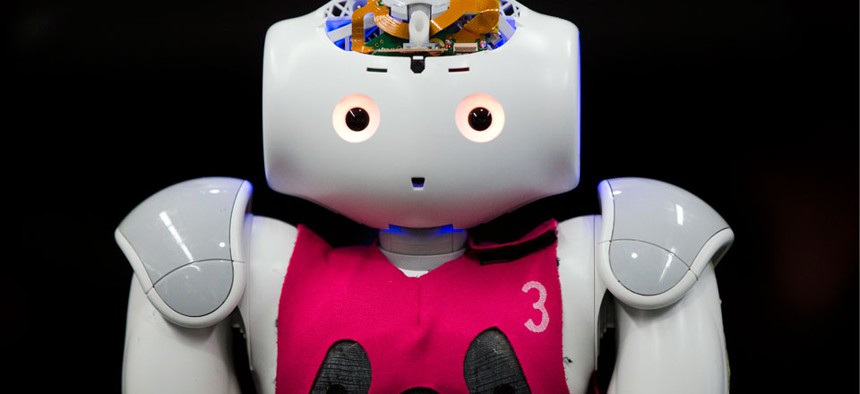Why This Tech Historian Thinks Robots are the Key to Human Innovation

Created by students at the University of Pennsylvania, a RoboCup entry known as Nao will learn to make quick, smart decisions while working in a changing environment. Matt Rourke/AP
Federal researchers and policy-makers need to team up not only with each other but also with machine counterparts.
Walter Isaacson is an acclaimed CEO, editor and author of several books about revered innovators, such as Albert Einstein, Benjamin Franklin and Steve Jobs.
He’s sure the key to human innovation is collaboration.
But more and more, that collaboration is involving nonhuman partners.
Federal researchers and policy-makers will have to team up not only with each other but also with machine counterparts to truly innovate and capitalize on this era of emerging digital technologies, Isaacson said Oct. 20 at the CA Technologies Government Summit in Washington.
Unlike the days when single visionary minds like Einstein and Franklin could forge a new path for humanity’s future, “real invention happens in the digital age through teamwork,” he said.
Innovation is a team sport, Isaacson said.
“Putting together a great [technology] team is like putting together a great baseball team,” he added. “It takes all sorts of people with different talents.”
In the last decade, machines have emerged as viable teammates, Isaacson said.
Broadly, artificial intelligence, sophisticated computer algorithms and drone vehicles all fall under the umbrella definition of machine.
There are already a plethora of examples that show machines make great partners. IBM’s Watson, an artificial intelligence platform that emerged from a research project, made headlines in 2011 when it competed on television’s Jeopardy! -- and defeated the show’s greatest human champions, Ken Jennings and Brat Rutter.
Watson has since become a mainstay in the field of cognitive computing, much like the Google self-driving car is now the poster machine for autonomous vehicles.
Those technological innovations that began as concepts in research labs are but a few examples sure to have a major impact on public sector missions in the near future.
“Remember the triangle: The intersection between government, corporations and academic research,” Isaacson said. “Research is the seed corn for future innovation.”
The Singularity is ... Probably Not Near
Some futurists postulate that artificial intelligence might one day overtake the thought capacity of humans and potentially replace us as the dominant thinking species on Earth in what’s been referred to as a “technological singularity.”
Elon Musk, the founder of SpaceX and CEO of Tesla, even told a recent audience at the Massachusetts Institute of Technology that artificial intelligence is humanity’s “greatest existential threat” and likened building advanced AI to “summoning the demon.”
Isaacson cautioned that machines are still far from truly topping human thought capacity. In fact, a negative attitude toward machine innovation indirectly affects humanity’s ability to technologically evolve itself, he said.
Trying to have a conversation with even the most sophisticated algorithm or robot – the basis for the Turing Test, created by scientist Alan Turing more than 50 years ago – remains an exercise in futility. Machines still aren’t that much closer to exhibiting behavior that would make them indistinguishable from a human, Isaacson said.
But their ability to process what humans program them to do has increased exponentially.
“The only machines that are close to passing the Turing Test are gimmicky,” Isaacson said. “Machines have become our partners, we haven’t gotten to that singularity – that level of artificial intelligence – that people warn about.”
And until machines start exhibiting Skynet-like capabilities, Isaacson said the government will be best served reserving spots in their tech rosters with machines and algorithms.
NEXT STORY: Should Schools Mandate Computer-Coding Classes?



